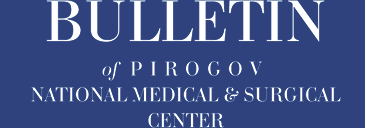Authors
Sukovaty B.S.1, Nazarenko P.M.1, Pashkov V.M.1, Mutova T.V.1, Ozerov A.A.2, Gruzdov A.Yu.1
1 Kursk State Medical University, Kursk
2 Kursk City Clinical Hospital of Emergency Medical Care, Kursk
Abstract
Rationale: The modern trend of Russian and world herniology is to shift the emphasis towards endoprosthetics of the abdominal wall with lightweight prostheses that do not significantly affect the quality of life of patients after surgery. However, the disadvantage of lightweight meshes is their insufficient strength due to the weak strength of the connective tissue of the abdominal wall during their implantation. The connective tissue capsule around the prosthesis cannot always sharply reduce the intra-abdominal pressure that occurs in some cases of relapse of the disease. A promising example of this problem is the use of bone marrow cells that stimulate tissue regeneration processes, which ensures a shorter period of formation of strong connective tissue.
Objective: to experimentally study the effect of bone marrow cells on the course of the wound process after subcutaneous implantation of a lightweight polypropylene prosthesis on aponeurosis of the rectus abdominis muscles.
Materials: The experimental study was performed on 30 rabbits divided into two groups of 15 animals. Subcutaneous implantation of a lightweight polypropylene prosthesis for aponeurosis of rectus abdominis muscles was performed in both groups. The animals in the first group were not injected with bone marrow cells. In the second group, after implantation of the prosthesis, bone marrow cells were taken from the crest of the rabbit ilium using a 2.5 ml spinal puncture needle. Then bone marrow cells of 0.5 ml were injected under the center of the prosthesis and in the area of its four corners to the places from which the process of implant rejection begins. On the 3rd, 7th, 14th, 21st, and 30th days after surgery, a section of the rabbit’s anterior abdominal wall was excised along with the implanted prosthesis and a standard histological examination was performed.
Results: The inflammatory reaction in the first group lasted 7 days, in the second – 3 days. The peak of the fibroblastic reaction occurred in the first at 14, in the second at 7 days. Durable connector.
Conclusion: the introduction of bone marrow cells into the implantation zone of a lightweight polypropylene prosthesis makes it possible to optimize the reparative processes in the wound.
Keywords: experiment, abdominal wall, lightweight polypropylene prosthesis, bone marrow cells.
References
1. Klinge U, Klosterhalfen В. Mesh implants for hernia repair: an update Expert review of medical devices. 2018; 15(10): 735-746. doi: 10.1016/s0045-7949(02)00485-6.
2. Netyaga AA, Parfenov AO, Nutfullina GM, Zhukovsekiy V.A. The effect of various types of endoprostheses for hernioaplasty on the condition of muscles in various parts of the abdominal wall. Kursk scientific and practical bulletin “Man and his health”. 2013; 4: 26-32. (In Russ.)
3. Lintin LAD, Kingsnorth AN. Mechanical failure of a lightweight polypropylene mesh. Hernia. 2014; 18(1): 131-133. doi: 10.1007/s10029-012-0959-5.
4. Ivanov SV, Lazarenko VA, Ivanov IS, Rozberg IP. The effect of potassium orotate on neocollagenesis during implantation of a polypropylene endoprosthesis and an endoprosthesis made of polypropylene with lactic acid in an experiment. Surgery. 2017; 3: 50-54. (In Russ.) doi: 10.17116/hirurgia2017350-54.
5. Lazarenko VA, Ivanov SV, Ivanov IS, et al. Morphological changes in the field of implantation of the endoprosthesis “Parietene ProGrip” depending on the use of the drug “Solcoseril”. Kursk scientific and practical bulletin “Man and his health”. 2016; 3: 74-80. (In Russ.) doi: 10.21626/vestnik/2016-3/12.
6. Achkasov EE, Bezuglov EN, Ulyanov AA, Kurshev VV. Application of platelet-enriched autoplasm in clinical practice. Biomedicine. 2013; 4: 46-59. (In Russ.)
7. Sukovatykh BS, Zatolokina MA, Mutova TV, Valuyskaya NV, Zhukovsky VA. The effectiveness of stimulation of reparative processes with platelet-enriched plasma during endoprosthetics of the abdominal wall. Bulletin of Experimental and Clinical Surgery. 2018; 11(4): 256-265. (In Russ.) doi: 10.18499/2070-478X-2018-11-4-275-284.
8. Irgasheva DZ, Halimova FT. Possibilities and mechanisms of action of stem cells for use in medical practice (literature review). Biology and integrative medicine. 2023; 63(4): 26-57. (In Russ.)
9. Dergilev KV, Vasilets YuD, Tsokolaeva ZI, Zubkova ES. Prospects for cell therapy of myocardial infarction and heart failure based on cardiosphere cells. Therapeutic Archive. 2020; 92(4): 111-120. (In Russ.) doi: 10.26442/00403660.2020.04.000634.
10. Namestnikova DD, Tairova RT, Sukhinich KK, et al. Cell therapy for ischemic stroke. Stem cell types and results of pre-clinical trials. S.S. Korsakov Journal of Neurology and Psychiatry. 2018; 118(9‑2): 69‑75. (In Russ.) doi: 10.17116/ jnevro201811809269.
11. Ganina AM, Askarov MB. The use of mesenchymal stem cells in the treatment of type 1 diabetes mellitus and its complications Universum: medicine and pharmacology. 2022; 4(87): 4-6. (In Russ.)
12. Averyanov AV, Sotnikova AG. Prospects of cellular technologies in the treatment of idiopathic pulmonary fibrosis. Practical pulmonology. 2019; 2: 43-48. (In Russ.)
13. Kotkas IE, Zemlyanoi VP. The effectiveness of the use of stem cells in the treatment of liver cirrhosis (Experimental study). Tauride Medical and Biological Bulletin. 2020; 23(1): 54-61. (In Russ.) doi: 10.37279/2070-8092-2020-23-1-54-61.


